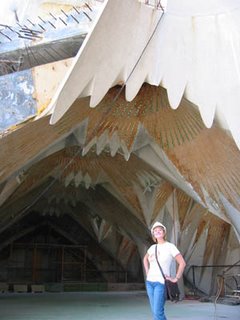
The Sagrada Familia is a massive structure. Begun in 1898, it is the bi-product of an eccentric, gifted, and probably mad neurotic known across the globe for the introduction of the word “gaudy…” a phrase I personally have afforded to numerous friends and their collective ensembles over the years. But seeing the works of Gaudi in person makes you realize that this was a man that, while some may consider his works tacky, was truly gifted. His use of space, light, color and geometry brought to life ideals of ancient worlds, stories of Christianity, and the desires of rich men with grand political ambitions.
While I hope that I experience even bigger and better adventures during the course of my preservation and architecture career, I kicked off my future with an enormous bang today. Perhaps one of the coolest events of my life, I was escorted to the top of The Sagrada Familia, where I observed the work of a master under construction. Though Gaudi has been dead for almost a century, his final project is still only approximately half complete. While construction crews hammer, plaster, weld and tile away on what must amount to miles of scaffolding, the public tour below. In what OSHA would surely call a nightmare, mobs of tourist contribute thousands of euros a day towards the completion of this monstrous temple to Christianity. Words like “Alleliua” and “Sanctus” loom 45m high, covered in elaborate tile mosaics… and I in my hard hat was close enough to reach out and touch them. Surrounded by artisans contributing to this overwhelming structure, I experienced what it must feel like to be an architect. To watch as the ideas that you conceived possible are created in front of your very eyes. I saw the bones of this beautiful building, barren to the steel core, surrounded by concrete, and all of it looking much too fragile to support the weigh of this colossal monument. High above the masses, feeling lofty in the face of my obvious tourist status, for a moment I felt godlike.
This is a great day.
While the rest of the afternoon passed in a whirlwind of lectures, sites and beauty, I cannot help but feel that we should have ended the day then – there was just no way to top it. The Hospital is an amazing structure showing both the educated genius of a creative master and that of an intelligent and thoughtful designer who researched his works so thoroughly that his design is still applicable to present day medicine. The Park Guell, another Gaudi, while stunning has of course been complete and overrun with locals and tourists alike for the better part of 100 years. And the Palau de la Musica, a theatre designed for audio as opposed to visual, exhibits the unity of good design of the past and present. All art deco in a distinctly European style, these amazing structures have been alive since their conception, functioning daily with a refined sense of style that is often lacking in American structures.
On a side note, as I sit at my computer looking out on the darkness of Barcelona, there is a sudden eruption of honking, screaming, shouting, cheering, fireworks, air horns, and what sounds like ecstatic rioting in the streets – I guess Barcelona just scored a point in the soccer game against Paris.
But hey, if they can’t beat the pansy ass French…
The noise is outlandish, deafening, sounding as though a civil war or the fourth of July is happening directly outside my window. It makes me nervous to know what will happen if Barcelona actually wins… Maybe I should go get a beer and get in on the action…
Pop. Scream. Pop. Whistle. Horns blaring. Fireworks. Scream. Horns. Police siren. Whistle. Tires screeching. The cheering of thousands of crazed fans…
On second thought, I think I’ll just go to bed early. If I can, that is.





